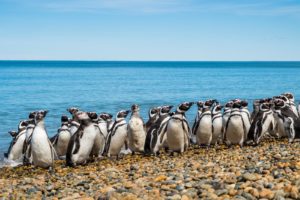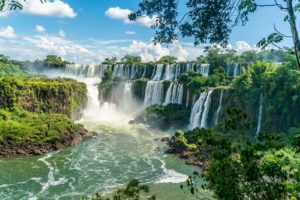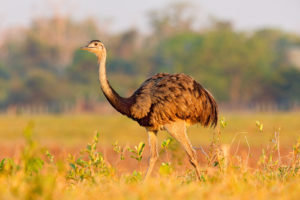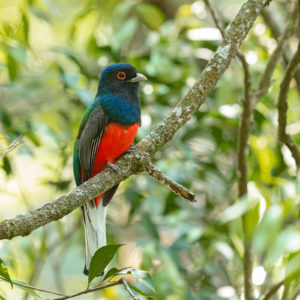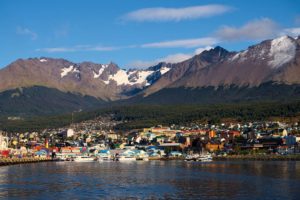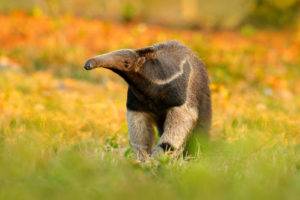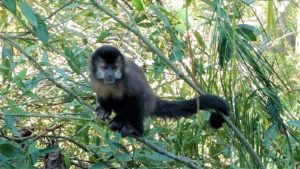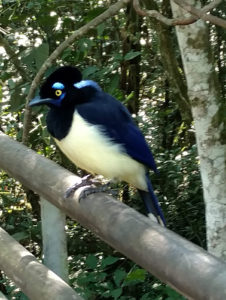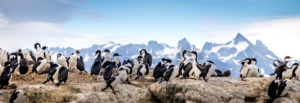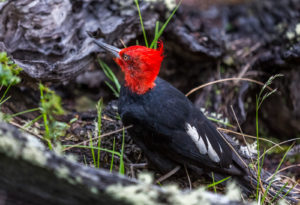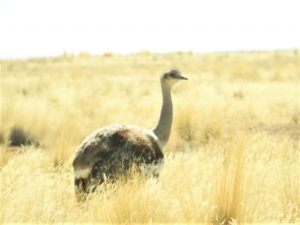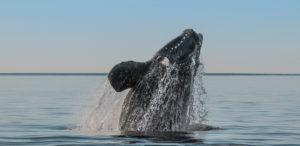Birding Argentina
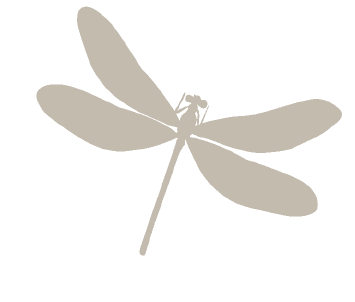
November 6 to November 21, 2021
$4,950 | ($500 deposit due upon registration)
12 participants max
J
oin NBNC for the trip of a lifetime as we explore the length and breadth of Argentina. Our adventure starts in northern Argentina at Iguazu Falls – truly one of the natural wonders of the world – and finishes at the southern tip of South America – the legendary Tierra del Fuego.
In between, we explore the famous Ibera wetlands in search of the Strange-tailed Tyrant, Southern Screamer and Giant Wood-Rail. We’ll go on a whale watch in search of the rare Southern Right Whale and visit Seal Lion and Elephant Seal rookeries on the Valdes Peninsula.
There so many special birds to see in this amazingly diverse country (1,000 plus) – interesting shorebirds like the America Painted-Snipe and Tawny-throated Dotterel, several species of penguin, albatross and the Snowy Sheathbill. And, of course, there are the spectacular land birds like the huge Magellanic Woodpecker and even huger Greater Rhea.
Additional Information
Flow of the Day: The itinerary is designed to maximize our experience with the great diversity of birdlife and ecosystems that Argentina offers. We won’t, however, be rushing from place to place to chase the largest species list possible. Our goal is to spend time appreciating the species we encounter at an enjoyable pace. Birding walks begin in the early morning, and we travel slowly to allow for the best bird and wildlife encounters.
While this is primarily a birding trip, we will also take time to enjoy the culture, the great food, and intriguing history. Marine mammals also feature prominently, with visits to a sea lion rookery and a whale watch at the Valdez Peninsula
Pre-tripping in Buenos Aires is encouraged! If you’d like some advice and where to go, talk to Chip about options.
Afternoon plans typically allow for some afternoon rest time at the lodges, though this is not always feasible when we are transferring between lodges and landscapes.
Climate: Temperatures will vary considerably with daytime highs in the 80’s in Iguazu and 50’s in Ushuaia. The periods of rain are likely throughout the country. We’ll need to be prepared for very varied conditions.
Clothing: Pack light field clothing of neutral colors. Bring several pairs of long pants and comfortable, light, airy shirts. Long-sleeved (relaxed fit) shirts are useful for protection from the sun, as is a light hat or cap. Good rain gear is essential, and a small umbrella is also recommended. Be sure to have a pair of comfortable walking shoes or hiking boots, plus a second pair of tennis shoes or sandals. A sweater or fleece is important for southern Patagonia. You may want more casual clothing for traveling or dinners. A small washcloth and handkerchiefs will be helpful.
Equipment: Bring a pair of binoculars, a field guide and a camera with extra batteries. The guides will have two spotting scopes. Pack sunglasses and sunscreen, a small flashlight or headlamp, a small alarm clock (a smartphone will work), insect repellent, a small daypack, and a small folding stool if you get tired standing for long periods observing birds and other wildlife. We will also supply a lengthier suggested packing list.
Health Considerations: Please consult your physician before the trip for any recommended immunizations. Mosquitoes can sometimes be a nuisance in northern Argentina. We suggest a stick-type repellent for your face and hands, plus at least one pump-style container of repellent for your clothing. As for foods, all salads, dairy products and meals at the different lodges are perfectly safe to eat. Bottled water is provided while on tours.
Participants should be able to hike on moderate terrain up to 3 miles per day, and be ready to expect conditions that may be hot, cold, dry, wet, or anything in-between.
Transportation: The land transportation is in a comfortable coach. Given the large distances we’ll be covering, there will also be several in country flights.
Our NBNC guide is NBNC Executive Director and expert birder Chip Darmstadt. Chip has guided NBNC excursions to Nicaragua, Costa Rica, Spain, Ecuador, as well as stateside locations like Magee Marsh and Cape May for over 20 years. Chip has a particular fondness for neotropical birds and had the pleasure of exploring Argentina in 2019.
North Branch Nature Center will be partnering with Clark Expediciones, based in Salta, Argentina. Founder Ricardo Clark has been a force behind conservation of the imperiled Yungas forests in the northern Andes. We will be joined by expert in-country bird guides, arranged by Clark Expediciones, throughout our entire adventure.
Please see day-by-day itinerary for details, but lodging ranges from nice 4-star hotels in Buenos Aires to comfortable lodges in rural areas.
The trip cost includes:
- Pre-departure orientation gathering at NBNC
- Expert NBNC guide
- In-country expert, English-speaking bird guide
- All accommodations starting and ending in Buenos Aires
- Entrance fees to parks and two boat rides
- Comfortable, private transportation throughout the trip, including airport transfers
- Bottled water, available at all times
- All meals during the trip starting and ending in Buenos Aires.
- Domestic (in Argentina) flights are included
The trip cost does not include:
- Airfare to and from Argentina
- Transportation to/from airports in the US
- Cancellation (trip) insurance
- Alcoholic beverages, snacks and other incidentals
- Extra hotel services, such as laundry
- Guide gratuities
Ready to go to Argentina?
Email [email protected] to get signed up.
Basic Itinerary
Day 1 – Nov 6 – Depart from US
*** note that we will likely need to fly from the US on November 7, in order to arrive in Buenos Aires on November 8. Participants may be interested in arriving a day or more earlier, in order to rest up and explore the city (there’s a lot to see in Buenos Aires!).
Day 2 – Nov7 – Morning arrival in Buenos Aires
Explore City and Reserva Costanera Sur. Buenos Aires is a fascinating city and is blessed with a wonderful nature reserve, Costanera Sur. The reserve is home to Black-necked Swan, Spectacled Tyrant, Masked Gnatcatcher and 14 species of rails, coots and gallinules! Overnight: Buenos Aires - Hotel Cyan Americas.
Day 3 – Nov 8 – Fly to Iguazu
Upon arrival in Puerto Iguazu we settle into our lodge and start exploring. Swallow-tailed Hummingbird, Toco Toucan, White Woodpecker and Green-headed Tanager are often found right in “downtown” Puerto Iguazu. Overnight: La Cantera Lodge or Yvy Hotel in Reserva Natural Yriapu.
Day 4 and 5 – Nov 9-10 – Exploring Iguazu
We spend mornings birding on the trails, in search of birds like Surucua Trogon, White-shouldered Fire-eye, Blond-crested Woodpecker, with afternoon visits to the amazing Iguazu Falls. The falls have to be seen to be believed, and we’ll also enjoy birds like the Great Dusky Swift, which nest behind the falls! Overnight: La Cantera Lodge or Yvy Hotel in Reserva Natural Yriapu.
Day 6 – Nov 11 – Salta Encantado
In the morning, we start heading south to Parque Provincial Salto Encantado. This provincial park also features a spectacular waterfall, as well as some special birds like Red-breasted Toucan, Rufous-breasted Leaftosser and Large-tailed Antshrike (species characteristic of the Southern Atlantic Rainforest biome). Overnight: Overnight at Hotel del Parque in Aristobulo del Valle.
Day 7 – Nov 12 – Northern Ibera
We continue south to Posadas and Ituzaingo to start our exploration of the northern Ibera wetlands area. This region is a birder’s heaven with many rare and unusual wetland and grassland species. In addition to birds like Strange-tailed Tyrant and Scarlet-headed Blackbird, we’ll also be on the lookout for interesting mammals like Cabybara and Giant Anteater. Overnight: Overnight in Ituzaingo.
Day 8 and 9 – Nov 13-14 – Ibera Wetlands
We’ll begin the day with some morning birding along the northern Ibera wetlands and then proceed to Colonia Carlos Pellegrini in the south of the wetlands. It will be a bird-filled day with many easily seen species, like Jabiru and Maguari Storks, Azure Gallinule, White-headed Marsh Tyrant and Southern Screamer. We’ll explore the marshes by boat our second day in the region. Overnight: Two nights at Ecoposada del Estero or a similar lodge in Ibera.
Day 10 – Nov 15 – Back in Buenos Aires
Today we drive south to Buenos Aires, birding as we go. Overnight: Buenos Aires near Aeroparque.
Day 11 – Nov 16 – Fly to Trelew
Following a morning flight to Trelew, we drive to Puerto Piramides in Valdes region, and begin our exploration of this fascinating area. The weather and landscape will be dramatically different, as well the bird life. Chilean Flamingo, Elegant Crested-Tinamou and Great Grebe are just a few of the interesting birds we may see. Two nights at ACA hotel Puerto Piramides
Day 12 – Nov 17 – Valdes Peninsula
A full day of exploring the Valdes Peninsula, including a visit to Elephant Seal and Sea Lion rookeries, as well as a Magellanic Penguin colony at San Lorenzo. Overnight: ACA Hotel Puerto Piramides.
Day 13 – Nov 18 – Valdes Peninsula
We’ll spend the morning on a whale watching boat trip in Golfo Nuevo. Valdes is one of the best places in the world to see the rare Southern Right Whale, and we may get lucky and see Orca as well! Midday transfer to Trelew airport to fly to Ushuaia. Overnight: Hotel Tolkeyen on the Beagle Channel.
Day 14 and 15 – Nov 19-20 – Tierra del Fuego
With two full days to explore the area, we’ll visit Martial Glacier our first morning, followed by an afternoon boat trip in the Beagle Channel to visit penguin rookeries. Our last day will be a full day tour of Tierra del Fuego National Park. Birding at the end of the earth is full of surprises and delights – Andean Condor, 3 species of caracara, White-bellied Seedsnipe, 3 species of oystercatcher, the stunning Thorn-tailed Rayadito, skuas and other seabirds. It will be a spectacular way to end our trip! Overnight: Ushuaia.
Day 16 – Nov 21 – Departure
Morning flight to Buenos Aires and transfer to Ezeiza airport for flight back home.
Detailed Itinerary
We will likely need to fly from the US on November 7, in order to arrive in Buenos Aires on November 8. Participants may be interested in arriving a day or more earlier, in order to rest up and explore the city (there’s a lot to see in Buenos Aires!).
Following an overnight flight, we arrive in the Argentine capital early in the morning and head to our downtown hotel (about an hour drive). The cosmopolitan city of Buenos Aires has a population of over 4 million people, but is considered to be one of the safest capitals in South America. There is a relaxed almost party-like atmosphere to the streets at night, as many of the residents gather at restaurants or take an evening stroll. At the time of our visit, it will be spring in Argentina and the many parks and gardens in Buenos Aires will be ablaze with color, as countless jacarandas and other tropical flowers burst into bloom.
After we have checked-in at our hotel there will be plenty of time to relax after the long flight, but for those eager to sample the new wilderness there is a wonderful reserve nearby. Costanera Sur is a remnant of the marshes, which once extended the length of the Rio de la Plata and is preserved as perhaps the most exciting urban bird sanctuary in the world. Within sight of the city buildings, we enter a wilderness of lagoons, marsh and scrub inhabited by a host of wetland species. Coypus (Nutria) sprawl in the sun or graze the reed-bed margins, Spotted Tupinambis (a terrestrial iguana) run across the trails, Black-necked Swans sail serenely on the open water and Snail Kites are plentiful over the marshes. In this incongruous setting we can expect to find 60 species of birds including Limpkin, Southern Screamer, Coscoroba Swan, Rosy-billed Pochard, Red-fronted, White-winged and Red-gartered Coots, Wattled Jacana, Monk Parakeet and Yellow-winged Blackbird.
We drive back to our hotel at about 6 pm and later in the evening we will visit one of the many excellent restaurants in Buenos Aires to enjoy a traditional 'asado' (roast) at one of the famous "parrillas", catering to both vegetarians and meat-eaters. Optional Tango show can be booked from the hotel. Overnight in Buenos Aires - Hotel Cyan Americas.
Early breakfast and a short transfer of 20 minutes to the local Aeroparque to take our flight (1.5 hours) to Puerto Iguazu. We may get our first glimpse of the falls from the plane and we’ll also see extensive forests that beckon us to explore. After arriving at Iguazu, we’ll head to our hotel/lodge located amidst the forest of Yriapu Reserve, right at the edge of Iguazu National Park. Soon after checking in, we will make a short drive to Iguazu village for a visit to some superb hummingbird feeders. Run by a famous Brazilian lady, who maintains one of the best set of feeders in the country, the garden is often alive with the noisy zaps of up to seven busy species of hummingbirds. These include Swallow-tailed Hummingbird, the superb Black Jacobin, Black-throated Mango, Violet-capped Woodnymph and Versicoloured Emerald, together with Violaceous Euphonia, Blue Dacnis and plenty of Bananaquits. After lunch we drive back to our hotel for a rest. This afternoon we visit the renowned Iguazú Falls, perhaps the most spectacular waterfall system in the world. The falls are surrounded by humid subtropical rainforest, a habitat formerly more common in adjacent Brazil -known as the Atlantic forest. The falls themselves are truly one of the world's most impressive. On the Argentinian side, access is outstanding: a series of walkways bring you right up to the thunder and spray of the water, and to the Great Dusky Swifts that cling precariously to the rocks behind. Some wonderful birdwatching is awaiting for us here, including colorful tanagers, antbirds, toucans, manakins, motmots and trogons that will certainly thrill us.
We spend the morning today birding the famous Macuco Trail of Iguazu National Park, in search of typical Atlantic Forest species, such as Surucua Trogon, Rufous-capped Motmot, Creamy-bellied Gnatcatcher, White-eyed Foliage-gleaner, Robust Woodpecker, and Spot-backed Antshrike, among many others — all among a list that can exceed 50 specialties for the day! In particular, we will be hoping to find the exquisite Swallow-tailed and White-bearded Manakins, Tufted Antshrike, Ochre-collared Piculet, and the skulking Southern Antpipit. Enjoy a picnic lunch with a view of the falls, then explore in detail the Argentinean side of Iguazu. We use the park’s train system to get from one section to another, stopping at various viewpoints with the ultimate goal of reaching the most spectacular one: the Devil’s Throat. During the walk, it is possible to spot White-winged Swallow flying over the river, Yellow-billed Cardinal singing from the reeds, wild Muscovy Duck, Anhinga, kingfishers, herons ... and from the balcony at the Devil´s Throat, you can watch hundreds of Great Dusky Swift doing their acrobatic flight through the curtains of the falls to roost on the rocks behind the water.
We spend another full day devoted to Iguazu National Park. Early in the morning we drive out to other tracts through the forest – the famous road 101 – where we will find yet more new species, including perhaps a Streak-capped Antwren or croaking Spot-billed Toucanet. Typically birding the forests can be exciting when you find a mixed group, and these might include White-eyed Foliage-gleaner, Lesser Woodcreeper, the remarkable Black-billed Scythebill or a dapper Chestnut-bellied Euphonia. Birdlife tends to slow down dramatically by midday and we will then largely devote our time in the afternoon to admiring the spectacular waterfalls for which Iguazu is so rightly renowned. We walk both the upper and lower trails to immerse ourselves in this wonder, but also wildlife is an attraction as Toco and Red-breasted Toucans are regularly encountered, while hordes of Coatis loaf about. The catwalks to the various cascades host many superb species including the endangered Black-fronted Piping Guan and a variety of tanagers – such as Magpie, Green-headed and Swallow Tanager.
On our final morning at Iguazú we still have the chance of seeing some new species in the trees around our hotel on a pre-breakfast walk: Plain-winged Woodcreeper, Sepia-capped Flycatcher or a tiny Eared Pygmy Tyrant. Perhaps more views of Rufous-crowned Greenlet, a superb Blond-crested Woodpecker or the diminutive Creamy-bellied Gnatcatcher. Perched on bare trees above the forest maybe Toco Toucan or a Western Osprey or Snail Kite flying low overhead will bid us farewell as after a robust breakfast we depart for the drive southwards to our next destination in Misiones rainforest habitat with stops along the way that could yield Yellow-headed Caracara, White-eared Puffbird and perhaps Large-tailed Antshrike. From several vantage points along the road it is possible to enjoy views of the rainforest out to the horizon, where regular species include Grey-rumped Swift, Black-throated Trogon, Planalto Woodcreeper, Greenish Schiffornis and Red-rumped Cacique. After arriving to our hotel in Aristobulo del Valle, and time permitting, we will pay a visit to the nearby Salto Encantado Reserve, seeking to add Scale-throated Hermit, Yellow-fronted Woodpecker, the vocal Spix’s Spinetail, the recently split and fairly localized Scalloped Woodcreeper, and handsome yet skulking Bertoni’s and Dusky-tailed Antbirds. Low in the understory we will listen out for Southern Antpipit, and watch keenly for Black-tailed Tityra, the quietly perching White-throated Spadebill, White-necked Thrush, Chestnut-headed Tanager and Ultramarine Grosbeak of the Atlantic forest form.
We rise early for a short drive to Salto Encantado, where against a backdrop of rainforest Great Dusky Swifts depart their roost. New birds will come thick and fast in the forest as we seek the likes of Ochre-collared Piculet, Rufous-capped and Grey-bellied Spinetails, the canopy-skulking Spot-backed Antshrike, the reclusive Rufous Gnateater, outstanding male Blue Manakins, and Black-goggled and Ruby-crowned Tanagers. We will also hope to witness the faltering walk of the Short-tailed Antthrush and home in on a Purple-crowned Plovercrest lek, where males sit and ‘chip’ away at each other – vocally not literally! Then we set out on our coach driving southwards again into a completely different habitat in Wet Chaco area entering northern Corrientes province. Birdlife can be abundant and we will hope for views of a couple of tinamous - Red-winged Tinamou and Spotted Nothura, plus coasting Cinereous Harrier, parasitic Striped Cuckoo, rowdy Amazon Kingfisher and Brown-and-yellow Marshbirds.
After early breakfast we take a dirt road that will permit us to explore the northeastern border of the Ibera marshes while travelling to Colonia Carlos Pellegrini located in the southern edge of Iberá. Approaching Iberá, as we drop into more humid low-lying grasslands, seedeaters become a common sight with Double-collared, Tawny-bellied, Rufous-rumped and the extremely smart and endangered Marsh Seedeater. However, we will keep our eyes open along the road as we search for an iconic species of the Iberá Marshes - the red-faced and weird-looking Strange-tailed Tyrant. Small, forested islands are often home to Little Woodpeckers and Solitary Caciques. Scattered about the landscape, we will check for Grey Monjita and with luck a handsome Black-and-white Monjita. Small pools might provide us with good views of Plumbeous Ibis and Ringed Teal. Other wildlife includes Capybara (the world's largest rodent), Black Caimans, Howler Monkeys and Armadillos.
Iberá is a native word meaning "brilliant waters", and these are the largest "esteros" in Argentina, a huge complex of rivers, lagoons, grassy meadows and woodland that is home to a wonderful variety of wildlife. They are packed with Limpkins and Snail Kites and alive with a superb range of smaller birds together with wildfowl and waders. With two full days to explore, we will seek out the recently described Iberá Seedeater and visit marshes alive with Lesser Grass Finches, shocking Scarlet-headed Blackbirds and flocks of Brown-and-yellow and Yellow-rumped Marshbirds. Lesser Yellow-headed Vultures replace Turkey Vultures as they drift above the landscape bedecked with the huge and showy Giant Wood Rail. Rhythmic ticking should reveal the presence of smart Crested Doraditos. Taking a gentle stroll along a boardwalk through the marshes, brings noisy groups of Black-capped Donacobius, a good chance of Rufous-sided Crake, Green Kingfisher and Greater Thornbird, as well as Large Elaenia, smart White-headed Marsh Tyrants and Sooty Tyrannulets. As dusk approaches, Capybaras and a large gregarious nocturnal chinchilla, Plains Viscacha, emerge.
Our breakfasts can be a lush experience sitting in front of the marshes and surrounded by native woodland full of birds that also get attracted to the bird feeders set around. After enjoying the early activity we depart on our coach retracing steps northwards to Posadas airport. This is a slow and enjoyable morning drive as we go stopping to check convenient spots for those species we might be missing. Later on we arrive to Posadas for lunch and take a short flight to Trelew (probably via Buenos Aires).
We’ll make an early departure from Trelew to visit the famed Magellanic Penguin colony at Punta Tombo. Thousands of penguins nest on the beach at Punta Tombo and it is a sight to behold. In the afternoon we travel to a coastal hotel in the Peninsula Valdes resort of Puerto Piramides. The local economy owes a great deal to two particular aquatic creatures: the Southern Right Whale and the Magellanic Penguin. Both attract thousands of visitors to the area. Indeed it is claimed that the numbers of visitors each year exceed the figures for the Galapagos Islands!
The journey will take several hours on the long straight roads typical of the area around Trelew but our first sightings of Lesser (Darwin´s) Rhea and family parties of Elegant-crested Tinamous running along the roadside will keep us busy. The little resort of Puerto Piramides is situated on the south coast of Peninsula Valdés and overlooks the Nuevo Gulf where concentrations of Southern Right Whales occur. One of the largest of the great whales, these magnificent creatures were once hunted to the verge of extinction but numbers have gradually recovered and the population is now closely studied by scientists based on the Peninsula. Many cows spend the Patagonian summer in the waters off Valdés and at the time of our visit we may be able to see some of the newly born young swimming with their mothers. Looking out to sea from the shore we are likely to see whales spouting and witness their huge tails projecting above the waves! Occasionally a whale will leap clear of the water and to see this spectacular performance will be one of the tour highlights. Later in the afternoon, we will undertake a whale-watching boat trip to try and approach closer to the whales. In this way it is possible to get within a few meters but everything depends upon the co-operation of the animals, as it is definitely not permitted to harass these wonderful creatures.
The vastness of Peninsula Valdés will become apparent as we spend a day visiting the principal natural history sites on the north and east coasts. Much of the interior could best be described as moorland with extensive thickets of scrub and occasional marshy pools. Unusual species of plants grow here and we will hopefully encounter parties of Guanaco, a small very attractive member of the camel family, which still occurs on Valdés but is often hunted elsewhere in Patagonia. Not surprisingly these graceful animals are somewhat shy but another resident mammal, the Patagonian Hare or Mara, is frequently more confiding. An odd-looking creature with long thin legs, plump body and deer-like head, the Mara lives colonially in burrows and the occupants graze vegetation at a safe distance from the holes ready to rush back if alarmed. A handful of birds are typical of the bushy areas: Patagonian Mockingbird, Carbonated and Mourning Sierra-Finches and Yellow Finches. Other more elusive passerines also occur in the scrub including Band-tailed Earthcreeper, Rusty-backed Monjita and Grey-bellied Shrike-Tyrant. More open expanses are frequented by Southern Lapwing, Long-tailed Meadowlark and Rufous-backed Negrito and it is in this habitat that we may find Tawny-throated Dotterel and Least Seedsnipe.
It is the coastline of the Peninsula which most attracts attention and on favored beaches we can witness large numbers of Southern Sea Lions and Elephant Seals, together with attendant scavenging Kelp Gulls and Snowy Sheathbills. The mammals will be females and young males, the adult males having dispersed out to sea earlier in the spring, and many young pups should be evident in November. The rugged coastline is only accessible by road at particular vantage points and from these we can look down on the concentration of animals. Some of the young bulls interrupt long periods of loafing to indulge in practice fights with other young pretenders and there is much roaring and bellowing to disturb the tranquility of the scene. Birdlife is relatively sparse but Rock Cormorants breed on several cliffs, Giant Petrels and Black-browed Albatrosses glide offshore and both American and Blackish Oystercatchers inhabit the shoreline pools. A day on Peninsula Valdés inevitably involves a degree of coach travel, (it is over 100 kilometres from the tip of the Peninsula to the 'mainland'), but the assemblies of animals make the journey worthwhile and a surprising variety of birds can be discovered in this unspoiled wilderness.
We will spend much of the morning enjoying a more leisurely exploration of the Peninsula adjacent to Punta Piramide and a walk along the cliff top footpaths may provide more views of whales, plus the chance of a few seabirds. Manx Shearwaters regularly appear offshore although one can only guess the distances they must fly to reach this remote coastline. There is a colony of South American Terns on an island a short distance from the resort and a few Rock Cormorants also inhabit the cliffs. This morning may also be devoted to a whale watching trip if conditions or lack of time had precluded such a trip during the previous day. Later we drive back to Trelew airport and take a flight southwards down to Ushuaia.
Ushuaia is a pretty little settlement on the shores of the Beagle Channel, a collection of red-roofed buildings overlooked by snow-capped mountains in the most picturesque of settings. Cruise ships regularly call here and it is also a favorite holiday destination for many Argentineans, hence the presence of more hotels than might otherwise be expected in such a remote outpost. A short walk along the shoreline is sufficient to demonstrate that there are many differences in the local birdlife and the presence of Giant Petrels, Dolphin Gulls, Flightless Steamer Ducks and Great Skuas give a flavor of the sub-Antarctic avifauna, which characterizes this southern extremity of the country. The weather is capricious and warm sunny conditions can rapidly change to plummeting temperatures and snow, particularly when southerly winds blow from Antarctica.
We have three full days to visit a number of localities in the Ushuaia area and to undertake a half-day cruise on the Beagle Channel to Penguin Islands. The latter excursion will give an opportunity to obtain close views of various seabirds including Giant Petrel, Black-browed Albatross, Magellanic Diving Petrel and Imperial Shag, but it is also a voyage which takes us past stunning scenery, as mountains and forest fringe both shores of the Channel. It will also add another country to our itinerary as some of the little settlements we sail past are in Chilean territory! A small assembly of Magellanic Penguins can be viewed on one sandy headland, and although not quite the impressive spectacle of Valdes, they do have the added attraction of often being joined by several nesting Gentoo Penguins plus magnificent King Penguins wandering from further south. Also along the shore we will see pairs of the attractive Kelp Geese, many Upland Geese and possibly waders such as Magellanic Oystercatcher and White-rumped Sandpiper. Colonies of South American Tern are located on rocky islands in the Channel and Fur Seals can be seen at several places, often sharing their nursery with Imperial Shags, Dolphin Gulls and Snowy Sheathbills. Other possibilities during the cruise include Black-chested Buzzard Eagles and Andean Condors over the mountains, Black-faced Ibis, Ashy-headed Goose, Flightless and Flying Steamer Ducks.
Another birdwatching site near Ushuaia is a glacier on a mountain overlooking the town, which can be reached by a coach drive and a couple of hours hike. White-bellied Seedsnipe occasionally occur on the scree slopes below the glacier and other paramo species which may be located here include Grey-flanked Cinclodes, Ochre-naped Ground-Tyrant and Yellow-bridled Finch.
It is startling to think that only last century Tierra del Fuego was a largely unexplored wilderness and even today it retains a sense of isolation and remoteness that is rarely experienced in our crowded world. Apart from Ushuaia and Río Grande on the Atlantic coast, there are no towns of any size and isolated farms run the risk of being cut off for long periods during adverse weather. Herds of Guanaco still roam the interior and hardy birds like Tawny-throated Dotterel and Patagonian Yellow-Finches manage to survive in an inhospitable, windy terrain. The inevitable restrictions of time mean we can do no more than sample a brief glimpse of this extraordinary place. However, it will provide a fascinating experience and the contrast with the rainforest at the beginning of the trip is an illustration of the tremendous diversity of habitats within Argentina.
The Tierra del Fuego National Park just outside Ushuaia is a pleasantly wooded park, which follows the meanderings of a fast flowing river rushing down from the nearby mountains. The impressive, and absurdly confiding, Magellanic Woodpecker is one of the star birds found in the park, but other attractions include Dark-bellied and Bar-winged Cinclodes, Thorn-tailed Rayadito, Tufted Tit-Tyrant, Rufous-backed Negrito, Chilean Swallow, and Austral Thrush. Water meadows beside the river are inhabited by family parties of Upland and Ashy-headed Geese and a small lake contains Speckled Teal, Chiloe Wigeon, Flying Steamer Ducks and the scarce Spectacled Duck. Until recent years Torrent Ducks were often to be seen along the river, but they seem to be no longer present – although we can venture along the banks in hope of finding one. This is also a good spot to search for the skulking Magellanic Tapaculo. Considerably less attractive than the National Park is Ushuaia Rubbish Tip which we will briefly look at en route from the town. A trio of Caracaras can be found here - Southern, Chimango and White-throated, along with Kelp Gull, Great Skua and the occasional South Polar Skua.
There might be the chance for visiting Ushuaia city this morning, or perhaps trying for Magellanic Snipe in the flooded grassland of Hidden Bay but we soon have to get ready for a short transfer to the local airport in time to take our flight back to Buenos Aires. After arrival we drive for approximately one hour to the international airport in time to make for flights back home.

713 Elm Street
Montpelier, Vermont 05602
(802) 229-6206
Hours: Center Open Monday-Friday 9-4
Trails Open 24/7

